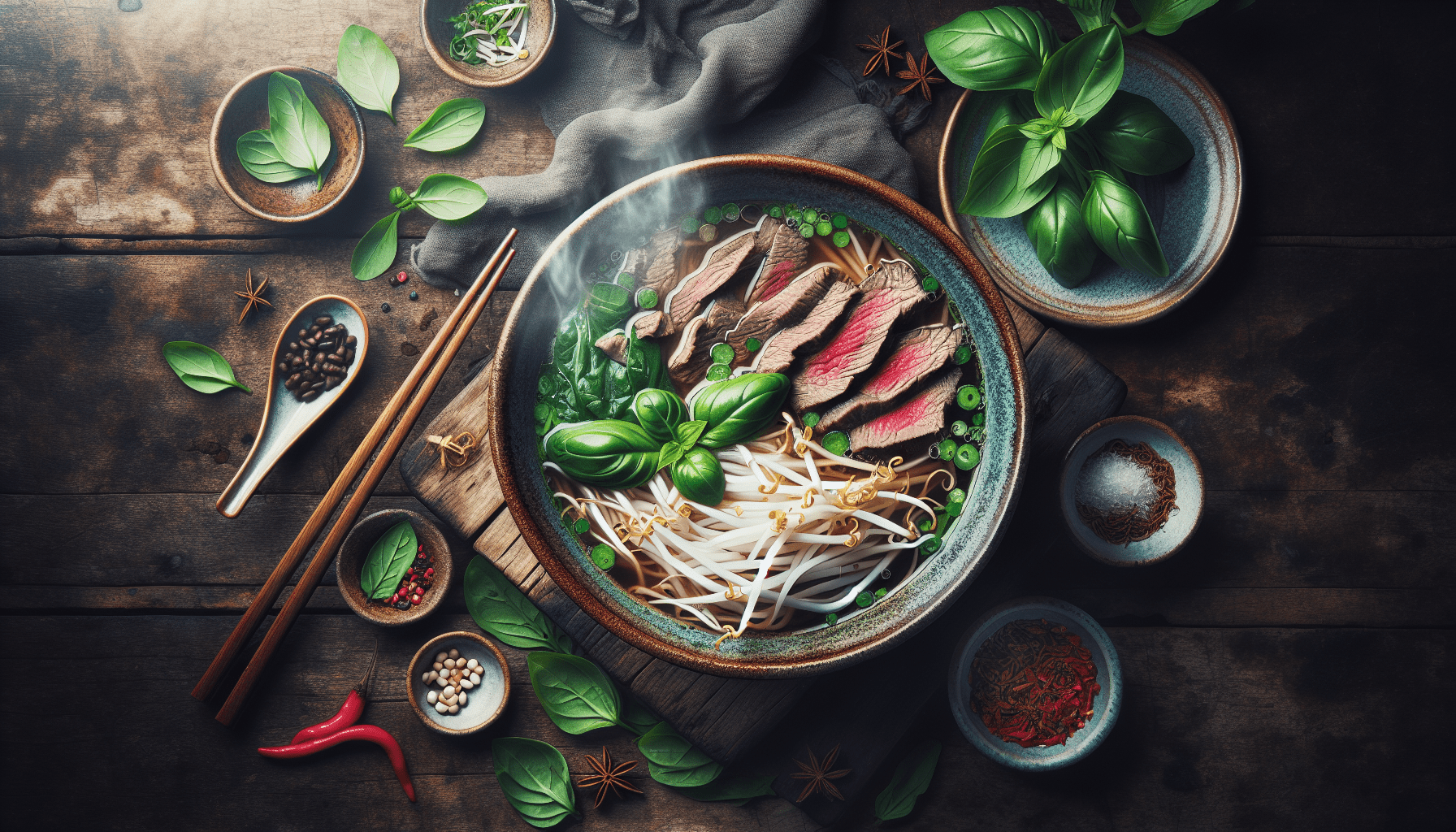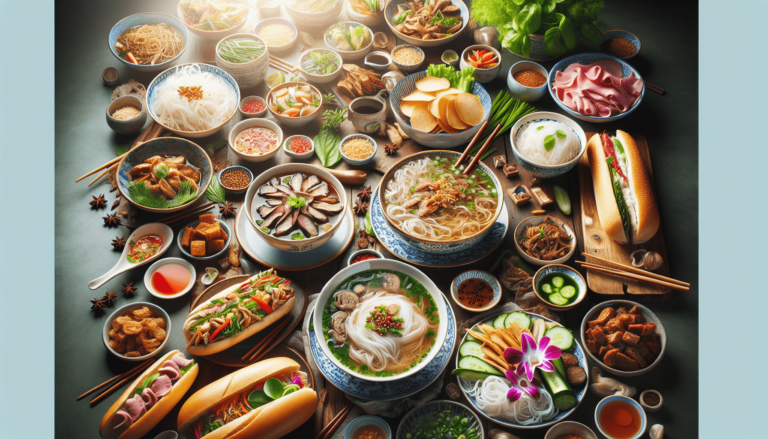Craving a bowl of pho but worried about your calorie intake? Well, you’ll be pleased to know that you can still enjoy this delicious Vietnamese dish even if you’re on a calorie deficit. Pho, a flavorful broth-based soup filled with rice noodles and various toppings, can be a satisfying and nutritious option for those looking to watch their calories. With its combination of lean protein, fresh vegetables, and aromatic herbs, pho offers a balanced meal that can be tailored to suit your dietary needs. So, why not satisfy your cravings while still sticking to your calorie goals? Swing by any of Eurasian Bistro’s locations in Pensacola and treat yourself to a bowl of pho that won’t derail your progress.

Understanding Calorie Deficit
Definition of calorie deficit
A calorie deficit occurs when you consume fewer calories than your body needs to maintain its current weight. In other words, you are creating an energy imbalance by burning more calories than you consume. This can lead to weight loss as your body taps into its stored fat for energy.
How a calorie deficit works
When you are in a calorie deficit, your body turns to its fat stores to make up for the energy shortfall. By consistently maintaining a calorie deficit over time, you can effectively shed excess pounds. This requires consuming fewer calories through your diet and increasing your physical activity to burn more calories.
Importance of maintaining a balanced diet in calorie deficit
While it’s important to create a calorie deficit, it’s equally crucial to maintain a balanced diet to ensure you’re getting all the necessary nutrients. This means choosing nutritionally dense foods that provide essential vitamins, minerals, proteins, carbohydrates, and fats. Restricting your calorie intake should not lead to nutrient deficiencies, so it’s vital to make wise food choices.
What is Pho?
Origin and history of pho
Pho is a traditional Vietnamese dish that has gained immense popularity worldwide. It originated in the early 20th century in Northern Vietnam and has since become a staple in Vietnamese cuisine. Pho is deeply rooted in Vietnamese culture and can be traced back to the French colonial period and the fusion of culinary influences during that time.
Ingredients usually present in a bowl of pho
A typical bowl of pho consists of three main components: the broth, the noodles, and the toppings. The broth is a flavorful and aromatic base made by simmering beef bones, spices, and herbs for several hours. The noodles used in pho are thin rice noodles that provide a light and delicate texture. Toppings can vary but often include thinly sliced beef or chicken, herbs like cilantro and Thai basil, bean sprouts, lime wedges, and chili peppers.
Varieties of pho
Pho comes in various forms, each with its own distinct flavors and ingredients. The two most popular types are pho bo (beef pho) and pho ga (chicken pho). Pho bo is made with beef broth, and the meat is typically thinly sliced beef or beef meatballs. Pho ga, on the other hand, uses chicken broth and is topped with chicken slices or shredded chicken. Regional variations and personal preferences can also lead to additional variations in pho, such as the addition of seafood or vegetarian options.
Nutritional Value of Pho
Calories in a bowl of pho
The number of calories in a bowl of pho can vary depending on serving size and ingredients. On average, a medium-sized bowl of pho contains approximately 350-450 calories. However, this calorie count can fluctuate based on the type and amount of protein, noodles, and toppings added to the dish. It’s important to be mindful of portion control when enjoying pho as part of a calorie deficit diet.
Vitamins and minerals present in pho
Pho is not only delicious but also provides a range of essential vitamins and minerals. The broth, made from simmering bones, is rich in nutrients like calcium, phosphorus, and magnesium. The addition of various herbs and vegetables, such as bean sprouts and Thai basil, contributes to the vitamin content of the dish. Pho can provide a significant portion of your daily requirement for vitamins such as vitamin C, vitamin A, and vitamin K.
Presence of proteins, carbs, and fats in pho
Pho offers a good balance of macronutrients. It contains a moderate amount of proteins from the meat or tofu toppings and is a source of carbohydrates from the rice noodles. The broth provides some healthy fats from the simmered bones, but the overall fat content in pho is relatively low. This combination makes pho a satisfying and nourishing meal option.
Pho and Calorie Deficit
How pho fits into a calorie-deficit diet
Pho can be an excellent choice for those on a calorie-deficit diet due to its lower calorie content compared to many other restaurant dishes. By being mindful of portion sizes and ingredients, you can enjoy a bowl of pho while still maintaining your calorie deficit. It’s important to balance the calorie content of the pho with the rest of your daily meals to ensure you stay within your desired calorie range.
Calorie count in different types of pho
The calorie content in pho can vary depending on the type and preparation method. Pho bo, which uses beef broth and beef slices, generally has a slightly higher calorie count compared to pho ga, which uses chicken broth and chicken toppings. It’s important to note that additional ingredients and condiments, such as hoisin sauce or Sriracha, can add calories to your pho. Opting for a lighter broth and lean protein choices can help minimize calorie intake.
Pho sizes and their calorie counts
Pho is typically available in different sizes, such as small, medium, and large. The calorie count will correspondingly vary based on the serving size. A smaller bowl of pho will generally have fewer calories than a larger portion. When aiming for a calorie deficit, choosing a smaller bowl or sharing a larger bowl with a friend can help control your calorie intake while still enjoying this satisfying dish.

Customizing Pho for a Calorie Deficit Diet
Choosing lean meats or tofu
To reduce calorie intake and promote weight loss in a calorie deficit, opt for lean protein choices when customizing your pho. Instead of fatty beef or chicken cuts, choose lean beef slices or white meat chicken. Alternatively, you can also go for tofu as a protein source, which provides fewer calories but still offers a substantial amount of plant-based protein.
Limiting noodles and focusing on vegetables
Since rice noodles contribute to the carbohydrate and calorie content of pho, you can reduce the calorie intake by limiting the amount of noodles in your bowl. Requesting a smaller portion of noodles or substituting them with extra vegetables can help create a more calorie-deficit-friendly dish. Load up on the fresh herbs and bean sprouts to add flavor and nutritional value to your pho.
Reducing portion sizes
Controlling portion sizes is essential when incorporating pho into a calorie deficit diet. While the flavorful broth and toppings can be tempting to indulge in, it’s important to be mindful of your portion size. Opting for a smaller bowl of pho or sharing a larger portion with a friend can help keep your calorie intake in check.
Benefits of Consuming Pho in a Calorie Deficit
Pho’s ability to satisfy hunger
Pho is a satisfying dish that can help curb hunger cravings while on a calorie deficit. The combination of protein, fiber, and broth helps provide a feeling of fullness and satiety. This can prevent overeating and contribute to better portion control throughout the day, supporting your overall weight loss goals.
How pho can provide essential nutrients
One of the advantages of pho is its nutrient density. Even when consuming fewer calories, pho still offers a wide range of essential nutrients. The broth provides minerals from the bones, while the various toppings and herbs contribute to the vitamin content. By incorporating pho into your calorie deficit diet, you can still nourish your body with important vitamins and minerals.
The role of pho in maintaining muscle mass in a calorie deficit
When in a calorie deficit, it’s important to prioritize preserving lean muscle mass. Pho can play a role in this by providing a source of quality protein. Protein is essential for muscle maintenance and repair, and including lean meats or tofu in your pho can help ensure your body has the necessary amino acids to support muscle preservation while losing weight.
Considerations When Eating Pho in a Calorie Deficit
Sodium content in pho
One consideration when consuming pho in a calorie deficit is the sodium content. Traditional pho broth is simmered with spices and herbs, and this can result in a higher sodium content. While sodium is an essential mineral, excessive intake can lead to water retention and higher blood pressure. It’s important to be mindful of your sodium intake from other sources and balance it with the rest of your diet.
Hidden calories in pho toppings and sauces
While pho itself is relatively low in calories, it’s important to be cautious about the additional toppings and sauces you add to your bowl. Toppings like fried shallots or additional meat can increase the calorie count of your meal. Similarly, sauces like hoisin or Sriracha can add flavor but also add calories. Opt for lighter toppings or consider using them sparingly to minimize calorie intake.
Importance of portion control
Portion control is key when incorporating pho into a calorie deficit diet. While pho can be a healthy and satisfying meal option, excessive portion sizes can lead to unintended calorie consumption. Be mindful when ordering or serving yourself pho to ensure you’re staying within your desired calorie range. When dining out, consider sharing a larger bowl or asking for a take-out portion to control portion sizes.
Alternatives to Pho for a Calorie Deficit
Other Vietnamese dishes that are calorie-deficit-friendly
If you’re looking for alternatives to pho while on a calorie deficit, Vietnamese cuisine offers a variety of options. Bun cha, a dish featuring grilled pork or tofu with vermicelli noodles and fresh herbs, is a flavorful choice with fewer calories than pho. Goi cuon, or fresh spring rolls, can be made with lean protein and packed with vegetables, making them a light and nutritious option.
Homemade pho alternative
If you have the time and inclination, you can also try making a homemade pho alternative that fits your calorie-deficit goals. By using a low-sodium broth, lean proteins, and incorporating plenty of vegetables, you can create a healthier version of pho that aligns with your dietary needs. Experiment with different flavors and ingredients to find a homemade pho alternative that you enjoy.
Vegetable-heavy dishes as alternatives
For a refreshing and nutrient-packed calorie-deficit meal, consider opting for vegetable-heavy dishes. Vietnamese cuisine offers various salads and stir-fried vegetable dishes that are flavorful and satisfying. Incorporating a combination of colorful vegetables, lean proteins, and a light dressing can provide a balanced meal while keeping your calorie intake in check.
Where to Eat Pho in a Calorie Deficit
Restaurant choices for calorie-conscious eaters
When dining out and looking for pho options that cater to calorie-conscious eaters, it’s important to choose restaurants that offer customization and transparency in their menu. Look for establishments that allow you to choose noodles, protein sources, and portion sizes according to your dietary needs. Additionally, checking online reviews and recommendations can help you find restaurants that prioritize healthier ingredients and preparation methods.
Recommendation to visit Eurasian Bistro locations in Pensacola
For those in Pensacola, a highly recommended choice for enjoying pho while on a calorie deficit is Eurasian Bistro. With multiple locations in Pensacola, Eurasian Bistro offers a variety of pho options that can be tailored to your dietary preferences. Their menu provides transparency in terms of calorie counts and ingredient choices, allowing you to make informed decisions based on your calorie-deficit goals.
Expert Opinions on Pho and Calorie Deficit
What nutritionists say about eating pho in a calorie deficit
Nutritionists generally agree that pho can be a nutritious option when consumed as part of a calorie deficit diet. It provides a balance of macronutrients, essential vitamins, and minerals while being relatively low in calories. However, they emphasize the importance of portion control and wise ingredient choices. Consulting with a nutritionist or registered dietitian can provide personalized guidance on incorporating pho into your specific calorie-deficit plan.
Studies related to pho and weight loss
While specific studies on pho and weight loss might be limited, research on calorie deficit diets and nutrient-dense foods support the inclusion of pho as part of a healthy eating plan. The combination of lean proteins, vegetables, and broth in pho aligns with the principles of a balanced diet for weight loss. An overall calorie deficit, along with regular physical activity, remains the key factor in achieving weight loss goals.
In conclusion, enjoying pho as part of a calorie deficit diet is entirely feasible. By customizing your pho choices, being mindful of portion sizes, and making wise ingredient selections, you can savor this delicious Vietnamese dish while staying on track with your weight loss goals. Remember to consult with a healthcare professional or nutritionist for personalized advice and recommendations tailored to your individual dietary needs. Bon appétit on your journey to a healthier you!







